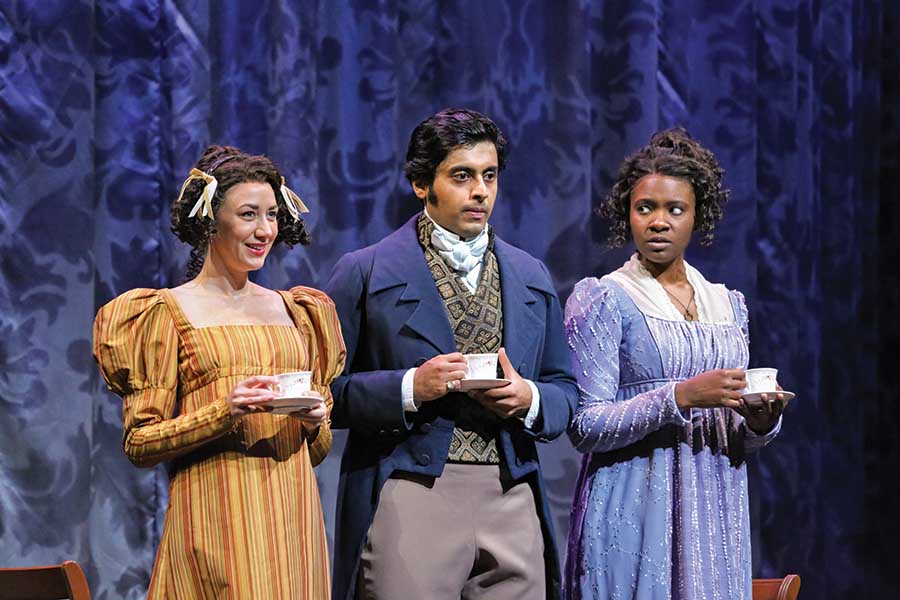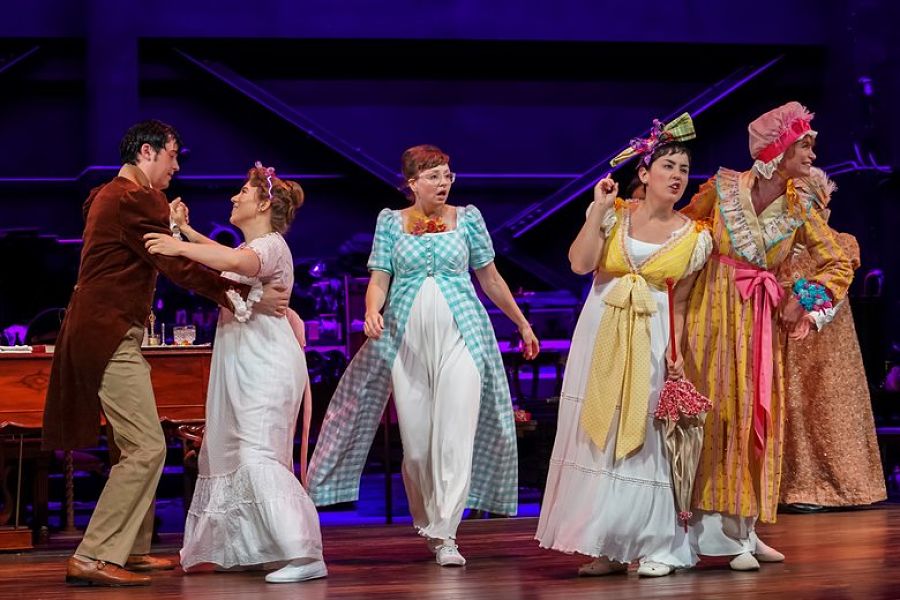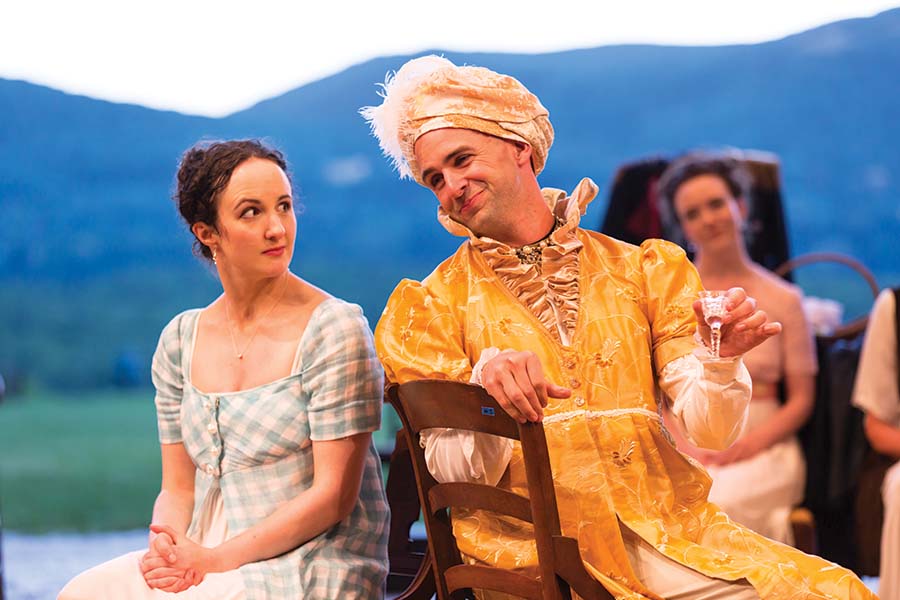Kate Hamill found inspiration, as many do, on a road trip. While traveling to Vermont a few years ago, Hamill told her car companion, fellow actor Andrus Nichols, that she was going to pen her first play, an adaptation of Jane Austen’s Sense and Sensibility. Hamill said she’d play the impressionable Marianne Dashwood, and Nichols the eldest Dashwood sister, Elinor, in the play’s first production. Hamill says that when the two passed a roadside diner called “Marianne’s,” she took it as a promising sign for her new playwriting venture.
This gambit to add “playwright” to her résumé was further spurred by a wager. “I bet her a hundred bucks,” says Hamill. “I was so poor at the time, and I really didn’t want to lose that $100. And that’s how it started.”
Sense and Sensibility, Hamill’s first full-length play, premiered in a production by New York City theatre company Bedlam at the Sheen Center in Manhattan, in a staging that starred, as planned, Hamill and Nichols as Marianne and Elinor Dashwood, respectively. It was a critical and box-office hit, and the production, directed by Eric Tucker, was mounted again in 2016, and it’s next up at American Repertory Theater in Cambridge, Mass., Dec. 10-Jan. 14, 2018.
Hamill, who received a BFA in acting from Ithaca College, was in her wheelhouse onstage, acting as the self-dramatizing Marianne in the play’s world premiere. But though she’s never taken a playwriting class, Hamill has a whole new wheelhouse—indeed, she stands at the helm of a nationwide resurgence of Jane Austen stage adaptations. Her adaptation of Pride and Prejudice premiered this summer at Hudson Valley Shakespeare Festival, which is also co-producing the show at Primary Stages in NYC, Nov. 7-Dec. 15, with Hamill starring as the perspicacious Lizzy Bennet.
Though she’s tackled only S&S and P&P thus far, there have been more than a dozen productions of her work since 2014, with many more to come: She’s on American Theatre’s Top 20 Most-Produced Playwrights list this season, with nine productions slated for 2017-18. And she’s currently at work on adapting another Austen novel, with plans to dramatize all seven before she’s done.
“The balance keeps me happy,” says Hamill of her newfound hyphenate career. “I find that if I do too much writing or too much acting without doing one or the other on the side, I start to miss the other one a lot.”
Her writing informs her acting, and vice versa. Says Christine Scarfuto, literary manager at New Haven, Conn.’s Long Wharf Theatre, who dramaturged P&P at HVSF, “As an actor herself, she understands exactly how much humor and charm actors can bring to her work, and she leaves a ton of space for that—which, as you can imagine, makes rehearsing with her an absolute blast.”
Hamill’s plays are ensemble works; she doesn’t write with lead actors in mind, least of all herself. But Lizzy Bennet was different; Hamill says she strongly identified with the novel’s protagonist. “She is quite awkward, she thinks she is capable of being a little over-clever, and congratulates herself too much on that—which is where she gets into trouble.”
Creating dynamic female characters is the whole attraction of this new career for Hamill.
“I started writing plays because I was so frustrated about the dearth of female-centric stories, and I was just seeing female artists drop out of the business all around me,” she laments. “Not only actors, but directors and designers.” She might have followed the same road before her Austen-spiration.
“I think some part of me was always waiting for permission or approval so that I could be designated that I could do this,” she admits. “Turns out, of course, women are conditioned to wait for permission—and we should just, like, not.”
Surely Jane would approve.

Hamill grew up in a dairy farmhouse just outside Ithaca in Lansing, N.Y., “a town with more cows than people,” she quips. “I was a small, high-energy, highly emotional child,” she recalls. Books and school theatre were lifelines out of the small town; her parents didn’t believe in television. “We grew up in a household that prized reading and literature, and I just read my ass off. I used to get in trouble for reading under my desk.” Her bedtime story rotation featured classic novels and Greek myths, including readings from The Odyssey by her father.
Among her under-the-desk books, of course, were Jane Austen’s novels. “I fell really in love with Austen and how funny and incisive she was,” says Hamill. “I got really annoyed when I got a little bit older and read some literary criticism of her, and the popular view of her was that she was just sort of a romance writer. I think it is just because she was a woman, so she gets painted with that brush. But actually she is just as much a brilliant social commentator as any other male writer, and so funny.”
Hamill’s adaptations masterfully bring the social commentary of the 19th century into the present. And the off-color humor buried in Austen’s margins is brought center stage. The notes in the script for Pride and Prejudice read: “If you think something could be a dirty joke, it probably is.”
Says Long Wharf’s Scarfuto, “Kate has an incredible ability to create a world that somehow feels true to the drawing rooms of Austen’s England and simultaneously very much of the present moment. The result is a take on Austen that’s playful, irreverent, and full of life—and smartly poking fun at those societal limitations that somehow, even now, we haven’t quite overcome.”
Lee Trull, the director of new-play development at Dallas Theater Center—where S&S took the stage in 2015—puts it this way: “Kate’s writing is all runny noses, scraped knees, and sweaty lips. The plays are fueled by moral outrage and public embarrassments. They tumble and break apart, and the characters that populate them always end up transformed by the end. This is why so many of us new-play people are obsessed with her.”
Trull notes that for Hamill, writing is an athletic endeavor, and that athleticism shows up onstage. The punchy, quick-witted language of S&S was set into motion by rolling furniture in Eric Tucker’s Bedlam production. At HVSF, the costumes sat onstage throughout P&P. The roles were multi-cast across genders and types, which meant that actors were running around the stage adding costume pieces mid-dialogue as they lapped the performance tent.
The marketing for Seattle Repertory Theatre’s recent P&P included a poster of a girl in a Regency frock, sporting boxing gloves. WaterTower Theatre in Addison, Texas, which staged P&P last month, released B-roll video of the show’s female characters with Elizabethan choker necklaces and sweatbands, dribbling basketballs down a court in a game against the men.
If playwriting were a sport, Hamill would be a high scorer. She has been running across the country this year championing productions of her work, sometimes performing in them. Next up are S&S at Colorado’s Arvada Center for the Arts and Humanities (Jan. 26-May 6, 2018); the Oregon Shakespeare Festival in Ashland (Feb.-Oct. 28); and Cape Fear Regional Theatre in Fayetteville, N.C. (April 21-29). She also just learned that her Austen adaptations will be produced in Australia and Israel.
But while she’s been prized as an eminent Janeite, Hamill isn’t a one-note wonder. Last year, her adaptation of William Thackeray’s Vanity Fair premiered at the now-defunct Pearl Theatre Company in NYC. She starred as the egocentric, social-climbing Becky Sharp in a production that pulled the 1848 novel into the 21st century, complete with a “Thriller” dance break. Hamill is an apt adaptor—an excavator of sorts—who can neatly fold the past into the present.
Also in the hopper: a musical adaptation of 20,000 Leagues Under the Sea, which she is co-writing with Trull and Shawn Magill; a stage version of Homer’s Odyssey, which had its first reading this summer at HVSF, and which flips the focus from Odysseus to Penelope; and the first play commission made by the Jungle Theater of Minneapolis, will be an adaptation of Louisa May Alcott’s Little Women.
And she’s not just an adaptor: Her original play The Little Fellow, or the Prostitute Play, follows Harriette Wilson, a notorious courtesan in 19th-century England.
“Stylistically, she’s channeling Austen, and Thackeray, and now Homer, but she’s also in deep conversation with Shakespeare, in terms of her dramaturgy and her approach to telling a story in a theatre,” says Davis McCallum, artistic director of Hudson Valley Shakespeare. McCallum has shepherded Hamill’s plays at HVSF, with four of her works getting their first reading at the theatre in Garrison, N.Y. “Where some theat-rical adaptations of great literature can feel like work, Kate’s are exuberantly playful.”

While there are countless Jane Austen adaptations and a myriad of fan fiction novels to draw on, Hamill doesn’t dive into any of this Austen-ania when working on her own adaptations. Her inspiration for her farce-like P&P, for instance, included Kenneth Branagh’s 1993 film of Much Ado About Nothing, episodes of “The Muppets,” and the film Clue.
“I tend to go in fits and spurts,” says Hamill about researching and writing. “For instance, the research for S&S made it easier to write The Prostitute Play because I already had some sense of that world.”
For her, it’s all about tone, she says, thought she admits that P&P was a challenge to adapt since it is such a “sacred cow” to Austen superfans. And her tone varies: At one end is the drawing-room marriage plot, at the other surprising grit and blood. Her original play In the Mines—which will have a reading at Abingdon Theatre Company in NYC later this year—is firmly on the latter side of the spectrum. Comprising three interconnected plays, loosely based on Greek myths about the underworld, it explores the depths of the West Virginia coal mine industry through the lens of the workers’ wives. There is folk music, a mine collapse, ghosts—and gore.
While it is always high time for high tea onstage, Hamill says that her darker work may be getting more stage light soon. “I thought, no one’s gonna produce this because it is so weird, and then of course the election happened,” she says. “All of a sudden, unfortunately, the rural working class and the history of why we need, I would argue, socially progressive populism is more relevant.”
For all her talent and hard work, Hamill is quick to credit her collaborators for easing her path from performer to dramatist. One of her most significant collaborators is her boyfriend, Jason O’Connell, who plays the Darcy to her Lizzy Bennet, onstage and off.
Offstage Hamill relaxes by swimming and cooking, though she has also recently taken up a very Austen-appropriate hobby: cross-stitching, a skill she learned during her stint in P&P. True to form, she’s given it her own impish twist: Her cross-stitch hoops, which she gives as gifts to her friends, bear such pithy sayings as “Bless This Motherfucking Home” and “Fuck This Fucking Shit.”
She may have to set aside her cross-stitching this year, though, as she continues to follow her work across the country, making Janeites out of theatregoers and turning theatregoers into Janeites.


